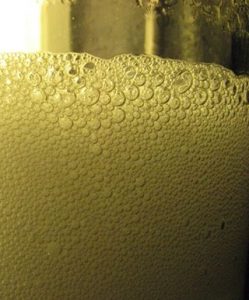Study: Dispersant Increases Oil Compounds Entering Atmosphere via Bursting Bubbles
– June 9, 2014
Scientists from Louisiana State University evaluated bursting bubbles as a pathway for hydrocarbons to move from the sea into the air and they investigated the influence of Corexit 9500A on this process.
They found that bursting bubbles transport alkanes (water insoluble oil compounds) to the atmosphere, independently from evaporation, and that the presence of dispersant increases the oil ejection rate. The researchers published their work in the November 2013 issue of The Royal Society of Chemistry’s Environmental Science: Processes & Impacts: Bubble bursting as an aerosol generation mechanism during an oil spill in the deep-sea environment: laboratory experimental demonstration of the transport pathway.
The oil and gas released from the Deepwater Horizon oil spill that reached the sea surface had two means of transport: marine and atmospheric. Most discussion of oil, dispersant, and associated toxins entering the atmosphere centers on evaporation, and previous studies estimate that approximately 5% of the spilled oil evaporated. However, the aerosolization of oil and oil-dispersant mixtures through whitecaps, sea spray, and mist has been “largely ignored” and may need to be considered in accounting for oil fate. While marine chemistry literature widely discusses the spray generation mechanism and its being a primary means for particles to enter the atmosphere, “the ejection of solely crude oil by bubble sprays and the effect of added dispersants have not been investigated extensively.” This study provides information that improves understanding of this process for an oil spill.
Researchers conducted a series of experiments on the ejection of oil alkanes from samples of weathered oil mousse, non-weathered crude oil (surrogate), and crude oil treated with Corexit 9500A. They simulated whitecaps to create bubbles as they might naturally occur at the air-sea interface with an aerosolization bubble column reactor. To evaluate alkane ejection, they used chromatography-mass spectroscopy; and to identify carbon fractions, they used a scanning electron microscope interfaced with energy dispersive X-ray images.
Results showed that the presence of Corexit 9500A increased the ejection rate of all alkane classes as compared to the ejection rate with just crude oil, but “especially for the C20-C29 [less volatile] alkanes.” The more volatile alkanes increased by 47.7% (C10-C14) and 24.4% (C15-C19). The less volatile alkanes increased considerably more: 168.2% (C20-C24) and 126.1% (C25-C29). The team concluded that oil compounds with high volatility will predominantly evaporate, but “larger compounds will be ejected via film droplets resulting from bursting bubbles” and that breaking waves and whitecaps can “positively facilitate the dispersion of the oil.”
Researchers explained that dispersants increased the oil ejection rate because they are designed to mix with only the oil droplets, making them smaller, scattering them in the water column, and reducing their coming back together. These smaller droplets become encased in bubbles as they rise to the surface because “air bubbles in the aqueous phase generally have higher capture efficiencies for finely dispersed surface active particles and droplets,” supporting their conclusion that “the bubbles and droplets produced at the surface will be capable of transporting a larger fraction of the oil via aerosolization.”
In their discussions, the researchers note that this aerosolization process “might be of particular importance for the fate of semi-volatile organic compounds as dissolution, microbial degradation, and evaporation are negligible for these compounds.” Their findings have implications for the off- and onshore environment because “these smaller particles are…subject to potential long-range transport.”
The team acknowledged that this is “still a little understood process” and that the “transport of oil spill matter into the atmosphere is a complex process, where multiple transport vectors will take place and have to be considered.” Kalliat Valsaraj, one of the study authors, spoke about the complexities of this process: “The actual particle generation by breaking waves depends on many factors. For example, field measurements under different wind conditions (the main parameter) can vary up to two orders of magnitude. This study contributes to the fundamental possibility of the particle-based transport as a proof-of-concept.” The authors recommend further study to find out if this process poses a threat to the environment at large.
The study’s authors are Franz S. Ehrenhauser, Paria Avij, Xin Shu, Victoria Dugas, Isaiah Woodson, Thilanga Liyana-Arachchi, Zenghui Zhang, Francisco R. Hung and Kalliat T. Valsaraj (Environ. Sci.: Processes Impacts, 2014, 16, 65-73).
************
This research was made possible in part by a grant from BP/The Gulf of Mexico Research Initiative (GoMRI) to the Consortium for the Molecular Engineering of Dispersant Systems (C-MEDS). The GoMRI is a 10-year independent research program established to study the effect, and the potential associated impact, of hydrocarbon releases on the environment and public health, as well as to develop improved spill mitigation, oil detection, characterization and remediation technologies. An independent and academic 20-member Research Board makes the funding and research direction decisions to ensure the intellectual quality, effectiveness and academic independence of the GoMRI research. All research data, findings and publications will be made publicly available. The program was established through a $500 million financial commitment from BP. For more information, visit https://gulfresearchinitiative.org/.
© Copyright 2010- 2017 Gulf of Mexico Research Initiative (GoMRI) – All Rights Reserved. Redistribution is encouraged with acknowledgement to the Gulf of Mexico Research Initiative (GoMRI). Please credit images and/or videos as done in each article. Questions? Contact web-content editor Nilde “Maggie” Dannreuther, Northern Gulf Institute, Mississippi State University (maggied@ngi.msstate.edu).






